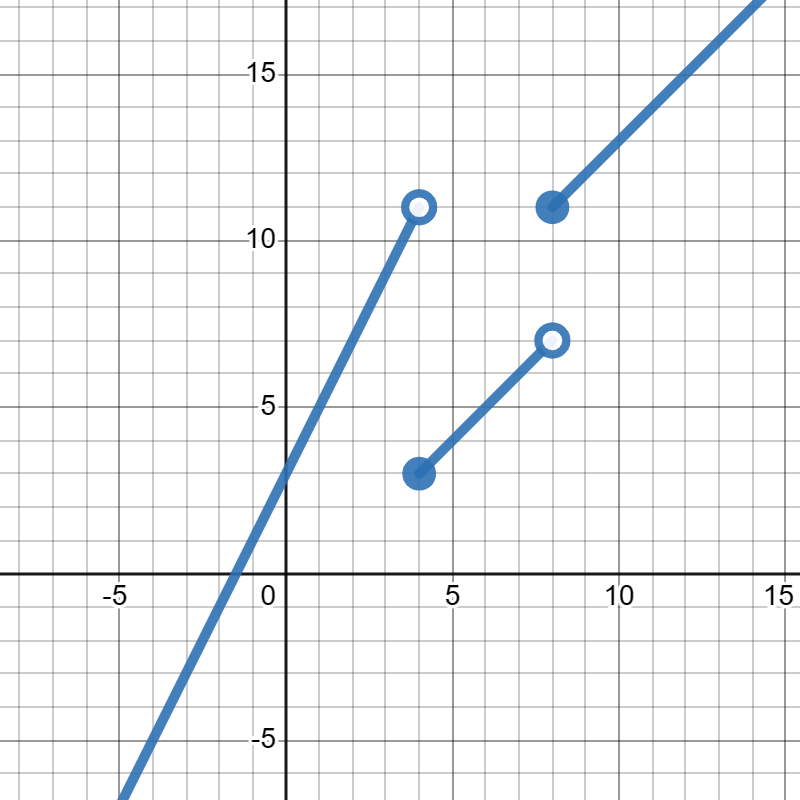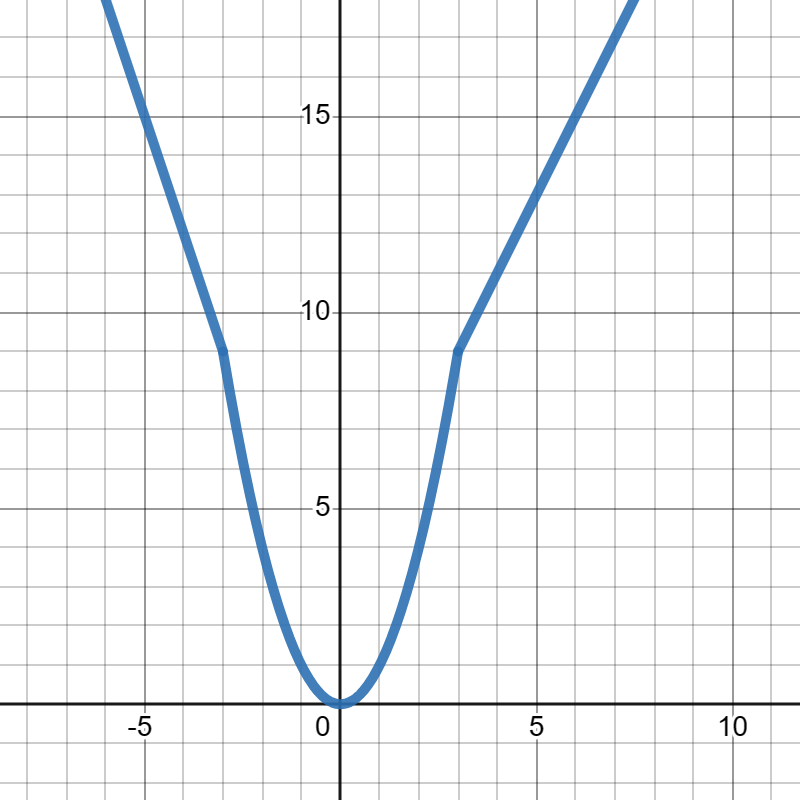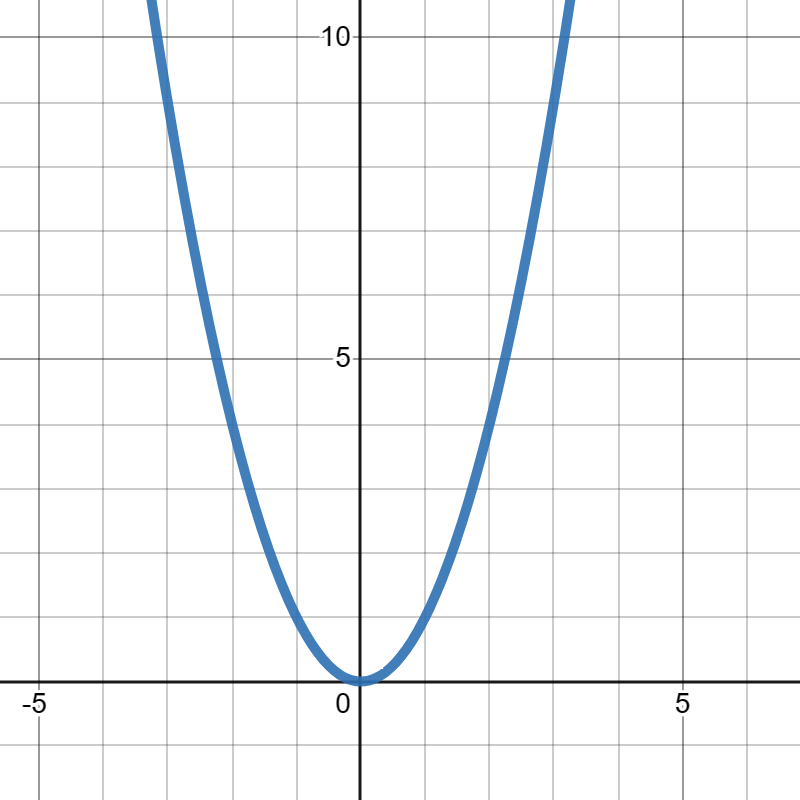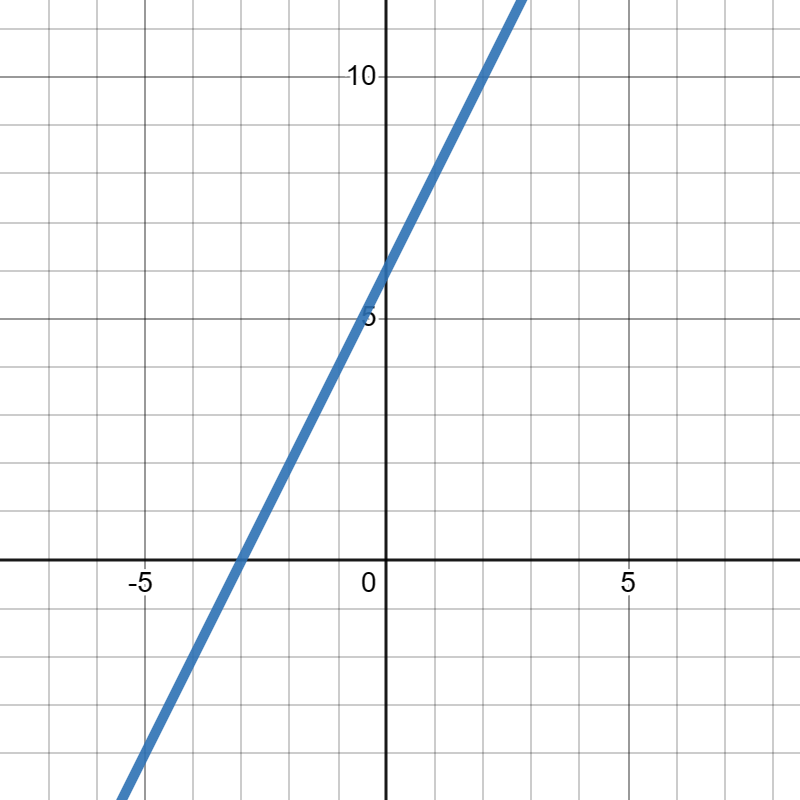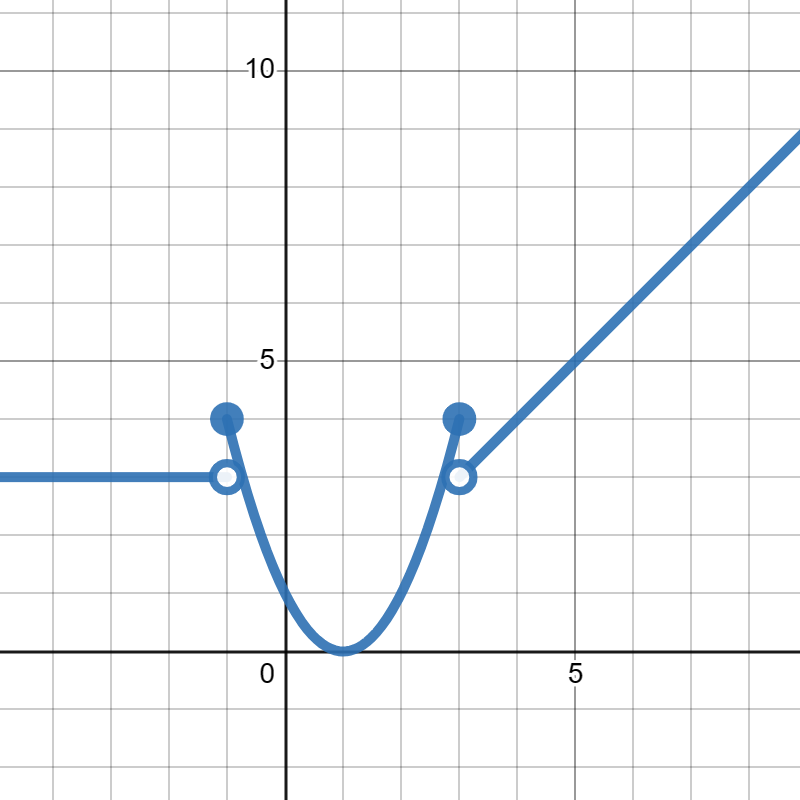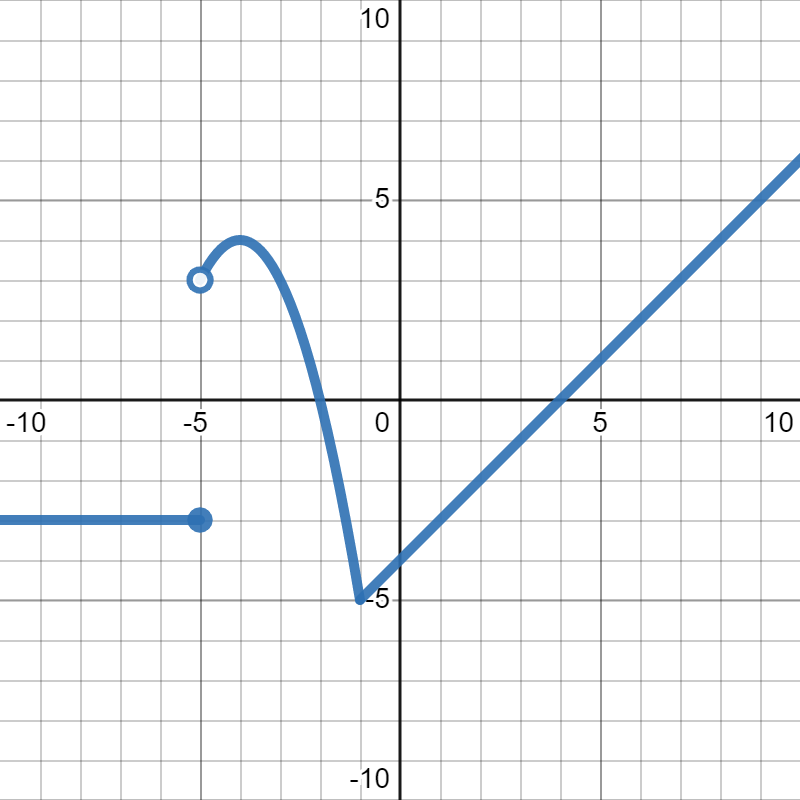Skip to main content\(\newcommand{\N}{\mathbb N}
\newcommand{\Z}{\mathbb Z}
\newcommand{\Q}{\mathbb Q}
\newcommand{\R}{\mathbb R}
\newcommand{\lt}{<}
\newcommand{\gt}{>}
\newcommand{\amp}{&}
\definecolor{fillinmathshade}{gray}{0.9}
\newcommand{\fillinmath}[1]{\mathchoice{\colorbox{fillinmathshade}{$\displaystyle \phantom{\,#1\,}$}}{\colorbox{fillinmathshade}{$\textstyle \phantom{\,#1\,}$}}{\colorbox{fillinmathshade}{$\scriptstyle \phantom{\,#1\,}$}}{\colorbox{fillinmathshade}{$\scriptscriptstyle\phantom{\,#1\,}$}}}
\)
Exercises 2.6 Practice Problems
Exercise Group.
For each of the following functions, evaluate at the given input.
1.
Answer.
-
\(\displaystyle f(3)=-21\)
-
\(\displaystyle f(4)=-29\)
-
\(\displaystyle f(-1)=11\)
-
\(\displaystyle f\left(\frac{3}{4}\right)=-3\)
2.
Answer.
-
\(\displaystyle f(3)=14\)
-
\(\displaystyle f(4)=20\)
-
\(\displaystyle f(-1)=-10\)
-
\(\displaystyle f\left(\frac{3}{4}\right)=\left(\frac{1}{2}\right)\)
3.
Answer.
-
\(\displaystyle f(3)=26\)
-
\(\displaystyle f(4)=26\)
-
\(\displaystyle f(-1)=26\)
-
\(\displaystyle f\left(\frac{3}{4}\right)=26\)
4.
5.
6.
\(f(x)=-\left(\frac{2}{3}\right)x + 1\)
Answer.
-
\(\displaystyle f(3)=-1\)
-
\(\displaystyle f(4)=-\frac{5}{3}\)
-
\(\displaystyle f(-1)=\frac{5}{3}\)
-
\(\displaystyle f\left(\frac{3}{4}\right)=\frac{1}{2} \)
Exercise Group.
For each of the following functions, evaluate at the given input.
7.
Answer.
-
\(\displaystyle g(c)=2-4c\)
-
\(\displaystyle g(2e)=2-8e\)
-
\(\displaystyle g(-k)=2+4k\)
-
\(\displaystyle g\left(\frac{1}{2}h\right)=2-2h\)
8.
Answer.
-
\(\displaystyle g(c)=3c-3\)
-
\(\displaystyle g(2e)=6e-3\)
-
\(\displaystyle g(-k)=-3k-3\)
-
\(\displaystyle g\left(\frac{1}{2}h\right)=\frac{3}{2}h-3\)
9.
Answer.
-
\(\displaystyle g(c)=12\)
-
\(\displaystyle g(2e)=12\)
-
\(\displaystyle g(-k)=12\)
-
\(\displaystyle g\left(\frac{1}{2}h\right)=12\)
10.
Answer.
-
\(\displaystyle g(c)=c-1\)
-
\(\displaystyle g(2e)=2e-1\)
-
\(\displaystyle g(-k)=-k-1\)
-
\(\displaystyle g\left(\frac{1}{2}h\right)=\frac{1}{2}h-1\)
11.
Answer.
-
\(\displaystyle g(c)=c\)
-
\(\displaystyle g(2e)=2e\)
-
\(\displaystyle g(-k)=-k\)
-
\(\displaystyle g\left(\frac{1}{2}h\right)=\frac{1}{2}h\)
12.
\(g(x)=-\frac{1}{4}x + 2\)
Answer.
-
\(\displaystyle g(c)=-\frac{1}{4}c+2\)
-
\(\displaystyle g(2e)=-\frac{1}{2}e+2\)
-
\(\displaystyle g(-k)=\frac{1}{4}k+2\)
-
\(\displaystyle g\left(\frac{1}{2}h\right)=\frac{1}{8}h+2\)
Exercise Group.
For each of the following functions, evaluate the given input.
-
\(\displaystyle f(x) = 2x+3\)
-
\(\displaystyle g(x) = 10x\)
-
\(\displaystyle h(x) = 0\)
-
\(\displaystyle y(x) = \frac{1}{5}x\)
13.
Evaluate all four of the above functions given
\(x=1 \text{.}\)
14.
Evaluate all four of the above functions given
\(x=a \text{.}\)
Answer.
-
\(\displaystyle f(a)=2a+3\)
-
\(\displaystyle g(a)=10a\)
-
\(\displaystyle h(a)=0\)
-
\(\displaystyle y(a)=\frac{1}{5}a\)
15.
Evaluate all four of the above functions given
\(x=0 \text{.}\)
Answer.
-
\(\displaystyle f(0)=3\)
-
\(\displaystyle g(0)=0\)
-
\(\displaystyle h(0)=0\)
-
\(\displaystyle y(0)=0\)
16.
Evaluate all four of the above functions given
\(x=2z \text{.}\)
Answer.
-
\(\displaystyle f(2z)=4z+3\)
-
\(\displaystyle g(2z)=20z\)
-
\(\displaystyle h(2z)=0\)
-
\(\displaystyle y(2z)=\frac{2}{5}z\)
17.
Evaluate all four of the above functions given
\(x=\frac{1}{2} \text{.}\)
Answer.
-
\(\displaystyle f\left(\frac{1}{2}\right)=4\)
-
\(\displaystyle g\left(\frac{1}{2}\right)=5\)
-
\(\displaystyle h\left(\frac{1}{2}\right)=0\)
-
\(\displaystyle y\left(\frac{1}{2}\right)=\frac{1}{10}\)
18.
Evaluate all four of the above functions given
\(x=b+5 \text{.}\)
Answer.
-
\(\displaystyle f(b+5)=2b+13\)
-
\(\displaystyle g(b+5)=10b + 50\)
-
\(\displaystyle h(b+5)=0\)
-
\(\displaystyle y(b+5)=\frac{1}{5}b + 1\)
19.
Suppose \(a(t)= \frac{1}{19}\text{.}\)
-
Evaluate \(a(1)\text{.}\)
-
Evaluate \(a(b+c)\text{.}\)
-
Evaluate \(a(9)\text{.}\)
-
Evaluate \(a(\frac{1}{19})\text{.}\)
Answer.
-
\(\displaystyle a(1) = \frac{1}{19}\)
-
\(\displaystyle a(b+c)) = \frac{1}{19}\)
-
\(\displaystyle a(9) = \frac{1}{19}\)
-
\(\displaystyle a\left(\frac{1}{19}\right) = \frac{1}{19}\)
20.
Suppose \(d(t)=\pi t\text{.}\)
-
Evaluate \(d(0)\text{.}\)
-
Evaluate \(d(a+h)\text{.}\)
-
Evaluate \(d(x)\text{.}\)
-
Evaluate \(d(\sqrt{x+3})\text{.}\)
Answer.
-
\(\displaystyle d(0) = 0\)
-
\(\displaystyle d(a+h) = \pi a + \pi h\)
-
\(\displaystyle d(x) = \pi x\)
-
\(\displaystyle d(\sqrt{x+3}) = \left( \pi \right) \left( \sqrt{x+3} \right)\)
21.
Suppose
\begin{equation*}
g(x) = \begin{cases}\sqrt{x} \amp x \gt 2 \\ x^2 \amp -3 \lt x \le 2 \\ x+3 \amp x \le -3 \end{cases}
\end{equation*}
We want to evaluate each of the following:
-
\(\displaystyle g(0)\)
-
\(\displaystyle g(-5)\)
-
\(\displaystyle g(10)\)
-
\(\displaystyle g(2)\)
Answer.
-
\(\displaystyle g(0)=0\)
-
\(\displaystyle g(-5)= -2\)
-
\(\displaystyle g(10)= \sqrt{10}\)
-
\(\displaystyle g(2) = 4\)
22.
Suppose
\begin{equation*}
h(t) = \begin{cases}\frac{1}{2}t \amp t \ge 3 \\ t^3 \amp 0 \lt t \lt 3 \\ t+3 \amp t \le 0 \end{cases}
\end{equation*}
We want to evaluate each of the following:
-
\(\displaystyle h(1)\)
-
\(\displaystyle h(3)\)
-
\(\displaystyle h(0)\)
-
\(\displaystyle h(-3)\)
Answer.
-
\(\displaystyle h(1) = 1\)
-
\(\displaystyle h(3) = \frac{3}{2}\)
-
\(\displaystyle h(0) = 3\)
-
\(\displaystyle h(-3) = 0\)
23.
Suppose
\begin{equation*}
f(t) = \begin{cases}\frac{1}{3}t \amp t \ge 5 \\ \sqrt{t} \amp 1 \lt t \lt 5 \\ t \amp t \le 1 \end{cases}
\end{equation*}
We want to evaluate each of the following:
-
\(\displaystyle f(1)\)
-
\(\displaystyle f(5)\)
-
\(\displaystyle f(0)\)
-
\(\displaystyle f\left(\frac{3}{2}\right)\)
Answer.
-
\(\displaystyle f(1) = 1\)
-
\(\displaystyle f(5) = \frac{5}{3}\)
-
\(\displaystyle f(0) = 0\)
-
\(\displaystyle f\left(\frac{3}{2}\right) = \sqrt{\frac{3}{2}}\)
24.
Suppose
\begin{equation*}
f(x) = \begin{cases}\frac{1}{x} \amp x \gt 0 \\ x \amp x=0 \\ -\frac{1}{x} \amp x \lt 0 \end{cases}
\end{equation*}
We want to evaluate each of the following:
-
\(\displaystyle f(-1)\)
-
\(\displaystyle f(0)\)
-
\(\displaystyle f(2)\)
-
\(\displaystyle f\left(\frac{1}{2}\right)\)
Answer.
-
\(\displaystyle f(-1) = 1\)
-
\(\displaystyle f(0) = 0\)
-
\(\displaystyle f(2) = \frac{1}{2}\)
-
\(\displaystyle f\left(\frac{1}{2}\right) = 2\)
25.
Suppose
\begin{equation*}
f(x) = \begin{cases}\frac{1}{2} \amp x \gt 10 \\ 2x \amp x=10 \\ -1 \amp x \lt 10 \end{cases}
\end{equation*}
We want to evaluate each of the following:
-
\(\displaystyle f(-10)\)
-
\(\displaystyle f(0)\)
-
\(\displaystyle f(10)\)
-
\(\displaystyle f(20)\)
Answer.
-
\(\displaystyle f(-10)=-1\)
-
\(\displaystyle f(0)=-1\)
-
\(\displaystyle f(10)=20\)
-
\(\displaystyle f(20)=\frac{1}{2}\)
26.
Suppose
\(g(x)\) is given in the graph below:
Evaluate each of the following:
-
\(\displaystyle g(-2)\)
-
\(\displaystyle g(4)\)
-
\(\displaystyle g(6)\)
-
\(\displaystyle g(8)\)
-
\(\displaystyle g(9)\)
Answer.
-
\(\displaystyle g(-2)=-1\)
-
\(\displaystyle g(4)=3\)
-
\(\displaystyle g(6)=5\)
-
\(\displaystyle g(8)=11\)
-
\(\displaystyle g(9)=12\)
27.
Suppose
\(f(x)\) is given in the graph below:
Evaluate each of the following:
-
\(\displaystyle f(-3)\)
-
\(\displaystyle f(0)\)
-
\(\displaystyle f(3)\)
-
\(\displaystyle f(5)\)
-
\(\displaystyle f(7)\)
Answer.
-
\(\displaystyle f(-3)=9\)
-
\(\displaystyle f(0)=0\)
-
\(\displaystyle f(3)=9\)
-
\(\displaystyle f(5)=13\)
-
\(\displaystyle f(7)=17\)
28.
Suppose
\(f(x)\) is given in the table below:
Table 2.6.1.
| \(x\) |
\(f(x)\) |
| \(-3\) |
\(1\) |
| \(0\) |
\(2\) |
| \(3\) |
\(-7\) |
| \(6\) |
\(/pi\) |
| \(\frac{1}{3}\) |
\(4.31\) |
Evaluate each of the following:
-
\(\displaystyle f(-3)\)
-
\(\displaystyle f(0)\)
-
\(\displaystyle f(3)\)
-
\(\displaystyle f(6)\)
-
\(\displaystyle f(\frac{1}{3})\)
Answer.
-
\(\displaystyle f(-3)=1\)
-
\(\displaystyle f(0)=2\)
-
\(\displaystyle f(3)=-7\)
-
\(\displaystyle f(6)=\pi\)
-
\(\displaystyle f(\frac{1}{3})=4.31\)
29.
Suppose
\(f(t)\) is given in the table below:
Table 2.6.2.
| \(t\) |
\(f(t)\) |
| \(0\) |
\(1\) |
| \(1\) |
\(2\) |
| \(2\) |
\(3\) |
| \(3\) |
\(4\) |
| \(4\) |
\(5\) |
Evaluate each of the following:
-
\(\displaystyle f(0)\)
-
\(\displaystyle f(1)\)
-
\(\displaystyle f(2)\)
-
\(\displaystyle f(3)\)
-
\(\displaystyle f(4)\)
Answer.
-
\(\displaystyle f(0)=1\)
-
\(\displaystyle f(1)=2\)
-
\(\displaystyle f(2)=3\)
-
\(\displaystyle f(3)=4\)
-
\(\displaystyle f(4)=5\)
30.
Suppose
\(f(x)\text{,}\) \(g(x)\text{,}\) and
\(h(x)\) are given in the table below:
Table 2.6.3.
| x |
f(x) |
g(x) |
h(x) |
| 0 |
9 |
4 |
1 |
| 1 |
-2 |
5.5 |
-3 |
| 2 |
6 |
6 |
6 |
| 3 |
7 |
0 |
8 |
| 4 |
-1 |
8 |
-4 |
Evaluate each of the following:
-
\(\displaystyle h(0)\)
-
\(\displaystyle f(1)\)
-
\(\displaystyle g(2)\)
-
\(\displaystyle f(3)\)
-
\(\displaystyle h(4)\)
Answer.
-
\(\displaystyle h(0)=1\)
-
\(\displaystyle f(1)=-2\)
-
\(\displaystyle g(2)=6\)
-
\(\displaystyle f(3)=7\)
-
\(\displaystyle h(4)=-4\)
31.
Suppose
\(m(x)\) is given in the table below:
Table 2.6.4.
| x |
1 |
3 |
5 |
7 |
9 |
| m(x) |
6 |
2 |
-1 |
-5 |
-8 |
Evaluate each of the following:
-
\(\displaystyle m(5)\)
-
\(\displaystyle m(1)\)
-
\(\displaystyle m(9)\)
-
\(\displaystyle m(3)\)
-
\(\displaystyle m(7)\)
Answer.
-
\(\displaystyle m(5)=-1\)
-
\(\displaystyle m(1)=6\)
-
\(\displaystyle m(9)=-8\)
-
\(\displaystyle m(3)=2\)
-
\(\displaystyle m(7)=-5\)
Exercise Group.
Suppose
\(f(x)= 3x-3\) and
\(g(x)\) is given in the graph below:
32.
Evaluate
\(2f(2)-g(0)+1\text{.}\)
33.
Evaluate
\(g(2)-(g(-2))^2\text{.}\)
34.
Evaluate
\(5g(-1)+4f(3)\text{.}\)
35.
Evaluate
\(\frac{1}{2}f(5)-2f(0)\text{.}\)
Answer.
\(\frac{1}{2}f(5)-2f(0)=0\)
36.
Evaluate
\((f(-2))^2-f(0)-(g(2))^3\text{.}\)
Answer.
\((f(-2))^2-f(0)-(g(2))^3=20\)
Exercise Group.
Suppose
\(f(x)= x\) and
\(g(x)\) is given in the table below:
Table 2.6.5.
| x |
1 |
2 |
3 |
4 |
5 |
| g(x) |
6 |
4 |
-1 |
7 |
0 |
37.
Evaluate
\(2f(2)-g(1)+1\text{.}\)
38.
Evaluate
\(g(4)-(g(3))^3\text{.}\)
39.
Evaluate
\(2g(1)-3f(5)\text{.}\)
40.
Evaluate
\(\frac{1}{2}f(10)-3f(1)\text{.}\)
Answer.
\(\frac{1}{2}f(5)-3f(1)=2\)
41.
Evaluate
\((f(-2))^2-g(2)-\frac{1}{3}g(5)\text{.}\)
Answer.
\((f(-2))^2-g(2)-\frac{1}{3}g(5)=0\)
Exercise Group.
Suppose
\(g(x)\) is given in the graph below and
\(h(x)\) is given in the table below:
Table 2.6.6.
| x |
0 |
2 |
4 |
6 |
8 |
| h(x) |
2 |
3 |
9 |
1 |
4 |
42.
Evaluate
\(4h(2)-g(0)+3\text{.}\)
43.
Evaluate
\(g(4)-\frac{1}{2}(h(6))^3\text{.}\)
Answer.
\(g(4)-\frac{1}{2}(h(6))^3=5.5\)
44.
Evaluate
\(2g(1)+4h(8)\text{.}\)
45.
Evaluate
\(\frac{1}{2}g(10)-3h(0)\text{.}\)
Answer.
\(\frac{1}{2}g(10)-3h(0)=-2\)
46.
Evaluate
\((h(4))^2-6g(2)-\frac{1}{3}g(1)\text{.}\)
Answer.
\((h(4))^2-6g(2)-\frac{1}{3}g(1)=30\)
Exercise Group.
Suppose
\(f(x)\) is given in the table below and
\(g(x)=\frac{1}{2}x+2\text{:}\)
Table 2.6.7.
| \(x\) |
\(f(x)\) |
| \(0\) |
\(2\) |
| \(1\) |
\(4\) |
| \(2\) |
\(6\) |
| \(3\) |
\(8\) |
| \(4\) |
\(10\) |
47.
Evaluate
\(3f(2)-g(2)+3\text{.}\)
48.
Evaluate
\(g(10)-\frac{1}{4}(f(3))^2\text{.}\)
Answer.
\(g(10)-\frac{1}{4}(f(3))^2=-9\)
49.
Evaluate
\(3g(1)+4f(4)\text{.}\)
50.
Evaluate
\(\frac{1}{5}g(6)-3f(0)\text{.}\)
Answer.
\(\frac{1}{5}g(6)-3f(0)=-5\)
51.
Evaluate
\((f(1))^2-2g(2)-\frac{1}{3}g(-4)\text{.}\)
Answer.
\((f(1))^2-2g(2)-\frac{1}{3}g(-4)=10\)
Exercise Group.
Suppose
\(f(x)= 4x-8\text{.}\)
52.
53.
Evaluate
\(f(0)\text{.}\)
54.
Evaluate
\(f(2)\text{.}\)
55.
Solve
\(f(x)=\frac{1}{2}\text{.}\)
56.
Solve
\(f(x)=10\text{.}\)
Exercise Group.
Suppose
\(g(x)\) is given in the graph below.
57.
58.
Evaluate
\(g(0)\text{.}\)
59.
Evaluate
\(g(1)\text{.}\)
60.
Solve
\(g(x)=-2\text{.}\)
61.
Exercise Group.
Suppose
\(f(x)\) is given in the table below.
Table 2.6.8.
| \(x\) |
\(f(x)\) |
| \(1\) |
\(3\) |
| \(2\) |
\(6\) |
| \(3\) |
\(9\) |
| \(4\) |
\(12\) |
| \(5\) |
\(15\) |
62.
Solve
\(f(x)=12\text{.}\)
63.
Evaluate
\(f(1)\text{.}\)
64.
Evaluate
\(f(3)\text{.}\)
65.
66.
Exercise Group.
Suppose
\(g(x)\) is given in the graph below.
67.
68.
Evaluate
\(g(-1)\text{.}\)
69.
Evaluate
\(g(1)\text{.}\)
70.
71.
Exercise Group.
Suppose
\(g(x)=(x-1)^2\) .
72.
73.
Evaluate
\(g(1)\text{.}\)
74.
Evaluate
\(g(2)\text{.}\)
75.
Solve
\(g(x)=16\text{.}\)
76.
